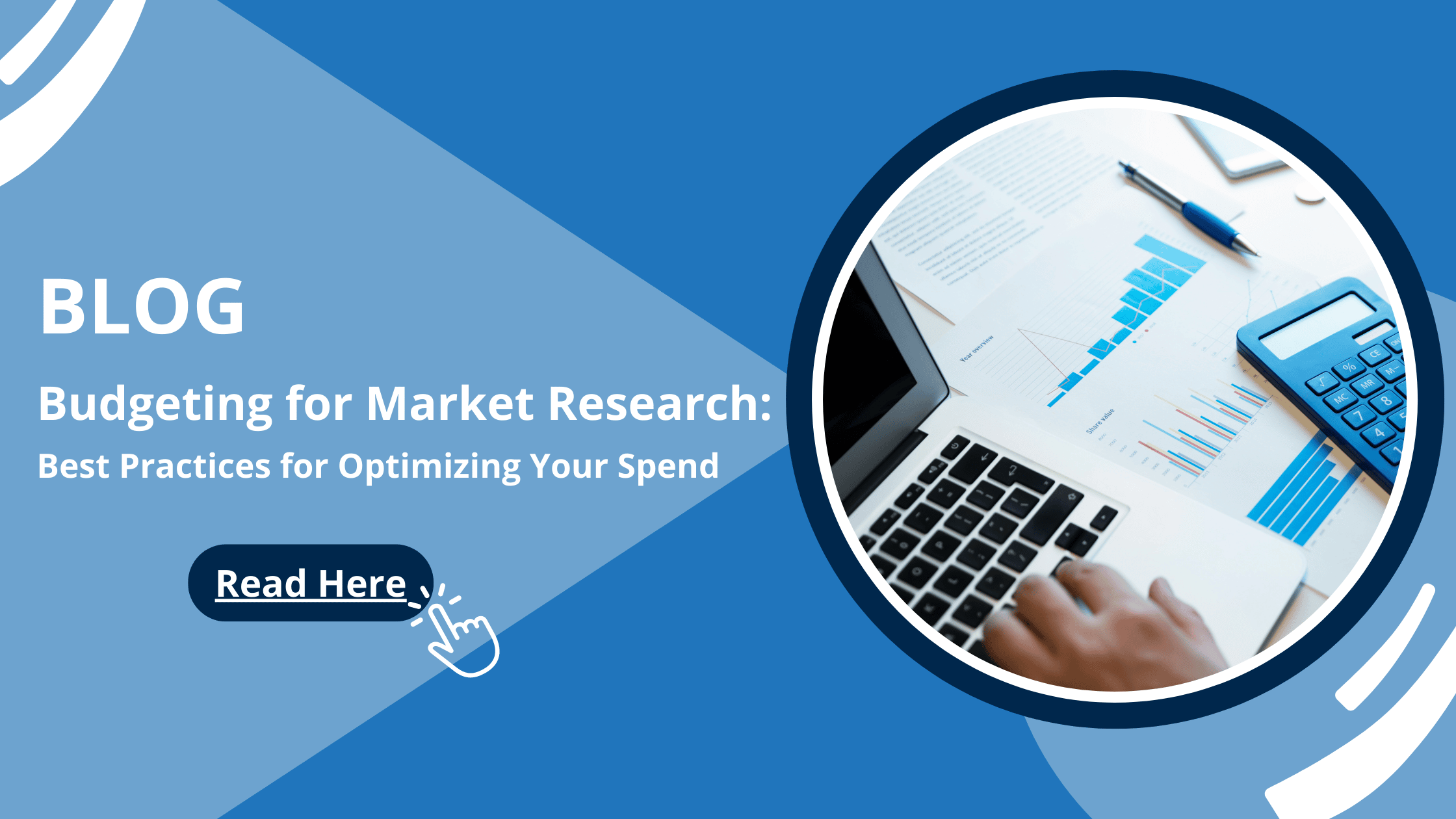Budgeting for Market Research: Best Practices and How to Optimize Your Spend

No matter their role, most people must justify where and how their spending their allotted budget to someone. Inevitably, throughout the year, there will be surprise expenses that come up, or unforeseen needs that maybe weren’t planned for initially during budgeting and approvals. Considering the weight it carries when it comes to your product and marketing strategies, market research should not be one of those unaccounted-for expenses. It’s important to make market research a part of your budget from the jump, but with fluctuation in pricing based on the research type, methodologies, and other variables, it can be challenging to accurately budget those expenses, especially if you’re new to the process.
In this post we’ll explore how to justify market research as a budget item, what to consider when determining your budget, and how to optimize the budget you’re given to maximize the success of your market research. Let’s dig in!
Budget Justification
Market research is a valuable tool for supporting your business decisions, but how do you communicate the value to those approving your budget? Here are a few examples of how market research provides value to your business:
1- Reliable Data to Inform Decision-Making
It’s not recommended that you make strategic decisions based on your own experiences or the anecdotal experience of others. You need evidence. Market research gives you reliable data and information to make evidence-based decisions.
2- Market Segmentation & Product Development
Market research gives you the ability to segment the market, so you can develop products, features, and services that directly address the needs of specific market segments. This, ultimately, will improve the success of your products across the markets you serve.
3- Forward-Looking Information
Without relevant research, you’re left to make decisions based on past consumer behavior. This can be risky, because, as you know, markets can change rapidly. An example that most all companies had to consider was COVID. If you were making decisions on how to move your business forward with data on pre-COVID consumer behavior, your strategy would not be in your best interest.
4- Understand Customer Perceptions
You need to understand how customers feel about your products, services, brand, and how you’re communicating. You can keep a pulse on your customer’s thoughts, opinions, and feedback through market research. This allows you to hear directly from your consumer how to improve.
Good market research brings clarity and objectivity and provides constant communication with you and your target audience, ultimately improving your products and services. Taking it a step further, successful market research helps you to meet your business goals, improves your customer satisfaction, gets you new customers, and retains your current customers.
There are several costs to consider when justifying and building your research budget. To name a few: subscriptions, publications, personnel needed to conduct and analyze the research, participant honoraria, supplies like prototypes, equipment, travel, facilities, consultants, agency needs, transcription and translation services.
It’s imperative that you take all these budget items into account, otherwise you may find that your driven to choose methodologies that aren’t appropriate for your needs, leading to decreased research quality, incomplete research, and insufficient answers to your research questions.
Determining Your Research Budget
When building your budget list all the research activities and associated milestones, so you can get estimates to assess costs for each research activity. Account for funding regulations or requirements and track all information in a dynamic spreadsheet that you’ll be able to use to monitor spend throughout the year.
If you have no idea where to start, designate approximately 15% of your total budget for research. This would include front-end research when you’re trying to build a strategy, back-end research when you’re trying to see if the strategy worked, and how you should move forward if you need to make changes.
Before you can build your detailed budget, you need to understand if you’re going to use internal information sources, external information sources, or a combination of the two. Internal information sources include data that your organization is generating, like sales data. If, for example, all you want to know is what your sales numbers are, trends, and how to segment customers based on their purchasing, you have that data in-house and won’t need to source anything externally.
Most of the time, your research needs will extend past what you have available to you internally. External information generally comes from the market as a whole and can give you a better indication of your position in the market and how to grow your business. When considering external data sources, first look to see if there are secondary sources to meet your needs. Secondary sources are high-level, off-the-shelf reports that provide data on the market, specific technology, or different trends. These reports are usually lower cost, or even free, and act as a great starting point with minimal time and money investment.
If you’re not finding everything you need from secondary research, then you will want to consider primary research. Primary research describes custom projects that are specifically designed to meet your needs and provide insights about your business, consumers, brand, and market position. Primary research methodologies include both quantitative and qualitative methodologies, and often call for a combination of the two.
The types of research your conducting, and the methodologies used will come with different price points and will carry different expenses based on factors like:
- Are you engaging a firm or consultant to conduct the research?
- What’s your sample size?
- What’s the length of the interview and/or survey?
- Do you need any technology components?
- Will you have any professional fees?
- Are there any associated travel expenses?
- Will you need additional resourcing to help with data analysis?
Keeping all these factors in mind will help you to accurately gauge the necessary budget allotment for market research throughout the year, secondary or primary.
How to Optimize Your Market Research Budget
You’ve done your due diligence to justify your market research budget and put together an accurate representation of your estimated budget needs. It’s approved! Now, it’s up to you to be a good steward of those funds and make the most out of the budget you have. Below we detail five ways to optimize your market research spend:
1- Clearly Define Goals and Objectives
One of the biggest wastes of market research dollars is an unfocused approach. Determine the focus of your research and define no more than 5 clear, actionable objectives. Objectives help to narrow your focus, drive the project, and ensure alignment with all your stakeholders. Objectives should be SMART: specific, measurable, achievable, relevant, and time-based. When defining your objectives, it’s best to be inclusive of your stakeholders’ feedback, especially those that will be using the output to make decisions.
2- Carefully Design a Sampling Plan
Your sampling plan should be based on your end goal, and should be targeted, but not so niche that you struggle to find anyone that fits your specifications. While sample size does have a direct impact on statistical power, it’s important to understand if you truly need statistical significance. If you don’t, then you can often save yourself some money on sample size. To build a sampling plan: define the target population, determine the sampling frame, select a sampling technique, determine sample size, and then execute. Consider how precise you need your data to be, costs associated with achieving your desired sample, and level of difficulty for reaching your target population.
3- Pick the Right Time
The goal is always to avoid knee-jerk, need-it-now market research. Ideally, market research should be used to inform strategic decisions, not to confirm decisions that have already been made. To appropriately plan, consider your strategic planning cycle, your budget schedule, and product development and marketing schedules. Proactively using market research to track key indicators will help you keep a pulse on your performance and allow you to catch problems before they arise.
4- Select the Best Method
To put it simply, don’t spend money on research methods that won’t give you the answers you need. Methodology should be determined based on desired results, not cost or convenience. Always start with secondary and internal data sources, then use primary custom research to fill any gaps, considering that mixed-method research may be your best option.
5- Think of Research as a Strategic Investment
Your competitors are using market research techniques- don’t get left behind. Market research allows you to set growth KPIs, understand your customers better, test products before launch, identify issues before they happen, and focus your message to target your audience. This gives you a huge competitive advantage and allows you to stay ahead of the competition.
There are several ways you can collect valuable market research. Regardless of your approach, taking your needs into account when budgeting is key to having access to the research you need to drive your strategic decision-making. To learn more about market research or get estimates for 2023 budgeting, contact us today. Our team of market research experts look forward to partnering with you!

